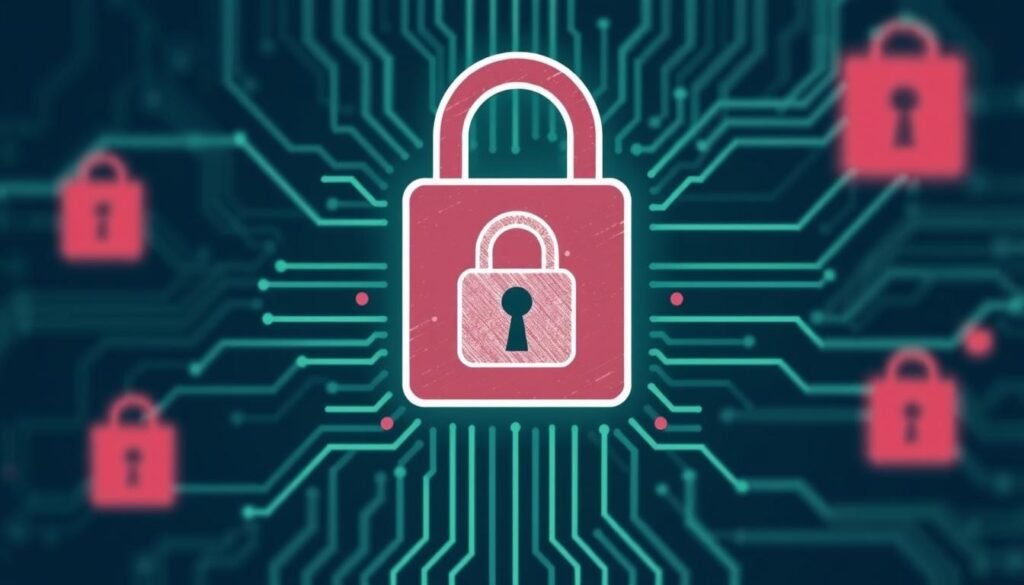Are you prepared for the unprecedented surge in cyberattacks that’s leaving businesses reeling? The cybersecurity world is bracing for impact as credential theft incidents skyrocket by a staggering 160% in 2025!
This isn’t just a minor glitch; it’s a full-blown crisis. Cybercriminals are exploiting stolen user credentials to gain unauthorized access to sensitive data, causing chaos across the digital landscape. The threat is real, and it’s not just large enterprises that are in the crosshairs – small businesses and individuals are increasingly being targeted.
The alarming rise in attacks is largely attributed to sophisticated phishing tactics and the dark web’s thriving market for stolen credentials. As security measures evolve, so do the tactics of attackers, creating a cat-and-mouse game where the stakes are higher than ever.
Key Takeaways
- The cybersecurity landscape is witnessing an alarming 160% surge in credential theft incidents.
- Cybercriminals are leveraging sophisticated tactics to bypass traditional security measures.
- Small businesses and individuals are increasingly becoming targets.
- Stolen credentials are being traded on the dark web, fueling further attacks.
- Organizations must adopt robust security strategies to counter these threats.
The Alarming Rise of Credential Theft in 2025
In 2025, the world witnessed an unprecedented surge in credential theft incidents, shattering previous records. The threat landscape has evolved dramatically, with credential theft becoming the preferred attack vector for cybercriminals. This isn’t just a minor bump in the road; we’re talking about a 160% explosion in credential theft incidents since 2024, representing the most dramatic increase ever recorded.

The 160% Increase in Credential Theft Incidents
The statistics are staggering: a 160% increase in credential theft incidents has left organizations across all sectors reeling. Financial services have been hit the hardest, with a 187% increase in credential-based attacks targeting banking portals, investment platforms, and payment processing systems. The dark web marketplace for stolen credentials has become a booming economy, with premium credentials selling for hundreds or even thousands of dollars.
For instance, in 2023, it was revealed that PayPal account credentials held significantly more value than social media, email, or credit card accounts, with an average price of $196.50 for an average account balance of $2,133.61. This lucrative market has incentivized threat actors to refine their tactics, making credential theft a highly sophisticated and profitable endeavor.
Why Cybercriminals Prioritize Credential Theft
Cybercriminals prioritize credential theft because it provides the cleanest path into secure systems. Legitimate credentials don’t trigger security alerts the way malware or exploit attempts do, making it a stealthy and effective method. The shift toward remote work has created a perfect storm of vulnerable access points, with home networks and personal devices becoming prime targets for credential harvesting operations.
As attackers continue to refine their tactics, it’s clear that security measures must evolve to counter this growing threat. The focus should be on protecting users and securing access to sensitive data and systems. By understanding the motivations behind credential theft, organizations can better prepare their defenses against these sophisticated attacks.
Understanding Modern Credential Theft
Credential theft is more than just a security threat; it’s a gateway to devastating breaches. Through sophisticated methods like phishing, fake login pages, or malware, attackers steal credentials to silently bypass defenses and move laterally across systems.
What Exactly Is Credential Theft?
Credential theft involves capturing authentication data that grants access to systems, applications, and sensitive information. It’s not just about stealing passwords; it’s about exploiting the very credentials that are meant to secure our digital lives.
The Evolution of Credential Theft Tactics
The methods used by attackers have evolved dramatically, from basic password guessing to complex operations involving AI-generated phishing, stealer malware, and social engineering. These tactics target both the technical vulnerabilities and the human element of security.
Why Traditional Security Measures Fall Short
Traditional security measures like static password policies and basic firewalls are woefully inadequate against modern credential theft techniques. These methods exploit behavioral patterns and technical vulnerabilities, making them highly effective.
The silent nature of credential theft makes it particularly dangerous. Unlike ransomware or DDoS attacks, stolen credentials can be used for weeks or months before detection occurs. Understanding the mechanics of credential theft is crucial for developing effective countermeasures.

The AI-Powered Threat Landscape
Cybercriminals are now leveraging AI to launch more convincing phishing campaigns and complex malware attacks! The threat landscape has dramatically changed, making it more challenging for organizations to defend against these sophisticated attacks.
AI-Generated Phishing Campaigns
AI-generated phishing emails are becoming increasingly convincing, making it difficult for users to distinguish between legitimate and malicious communications. These emails are crafted using machine learning algorithms that analyze vast amounts of data to mimic the writing style and tone of legitimate emails.
For instance, AI can scan millions of social media posts and corporate communications to craft phishing messages that precisely match organizational communication patterns. This level of personalization makes it easier for attackers to trick users into divulging sensitive information.
Deepfake Social Engineering Attacks
The use of deepfake technology in social engineering attacks has taken cybercrime to a new level. Attackers can now create videos or audio clips that impersonate executives or other trusted figures, making it easier to convince employees to perform certain actions or divulge sensitive information.
A notable example is the “Million-Dollar Zoom Scam” in 2024, where AI-generated video personas impersonating bank executives convinced an employee to transfer $35 million to fraudulent accounts.
AI-Enhanced Malware Development
AI-enhanced malware development has created a new generation of credential stealers that can dynamically adapt to evade detection. Some variants of this malware can change their code signature up to 15 times per day, making them highly challenging to detect using traditional security measures.
| Threat Type | AI-Powered Technique | Impact |
|---|---|---|
| Phishing Campaigns | AI-generated emails | Convincing users to divulge sensitive information |
| Social Engineering | Deepfake technology | Impersonating trusted figures to trick employees |
| Malware Development | AI-enhanced code generation | Creating highly evasive malware |
The democratization of AI tools has lowered the technical barrier to entry, allowing even low-skilled attackers to deploy sophisticated credential theft campaigns. As AI continues to evolve, it’s crucial for organizations to stay ahead of these threats by implementing robust security measures.
Common Credential Harvesting Techniques
The threat landscape for credential harvesting has evolved dramatically, with attackers employing sophisticated tactics to bypass traditional security measures. Modern phishing operations have become frighteningly sophisticated, with pixel-perfect replicas of login portals that even include real-time validation of captured credentials to confirm they’re active before the victim realizes what’s happened!
Sophisticated Phishing Operations
Attackers now deploy polished emails that redirect targets to malicious pages capturing credentials in real time. These phishing emails are designed to look legitimate, making it difficult for victims to distinguish between genuine and fake communications. The use of AI-generated content has further enhanced the credibility of these phishing attempts.
Zero-Day Link Generation
The traditional method of URL blacklisting has become obsolete due to zero-day link generation. Attackers create fresh phishing domains minutes before launching campaigns, ensuring that security tools have no prior intelligence about the threat. This technique has made it challenging for security systems to detect and block malicious links.
Phishing-as-a-Service Platforms
The rise of Phishing-as-a-Service (PaaS) platforms has democratized credential theft, allowing even non-technical criminals to deploy sophisticated campaigns. These subscription-based services include templates, infrastructure, and technical support, making it easier for attackers to harvest credentials. PaaS platforms offer turnkey operations with ready-made templates that clone banking and SaaS portals, automated dashboards that test stolen credentials, and one-click modules that bypass multi-factor authentication.
The combination of technical sophistication and targeted social engineering makes modern credential harvesting nearly impossible to detect with conventional security tools. As attackers continue to evolve their methods, it’s essential for organizations to stay ahead of the curve by implementing robust security measures.
Information Stealers: The Rising Threat
In the arsenal of cybercriminals, information stealers have become the weapon of choice. These malicious tools are engineered to extract a wide array of sensitive information from compromised systems, making them a formidable force in credential theft.
Anatomy of Modern Stealer Malware
Modern stealer malware has evolved to become the SWISS ARMY KNIFE of credential theft. These sophisticated tools can extract not just passwords, but also cookies, session tokens, API keys, and even cryptocurrency wallet data in a single infection. The anatomy of modern stealer malware reveals sophisticated evasion techniques including anti-VM detection, geofencing to avoid security researchers, and in-memory execution that leaves minimal traces on infected systems.
- Extracts saved passwords, cookies, and session tokens from Chromium and Firefox-based browsers.
- Targets cryptocurrency wallet data, tokens, and session data from messaging platforms.
- Steals email credentials, VPN, FTP, and Wi-Fi credentials, plus clipboard contents and screen captures.
Case Study: Katz Stealer in 2025
Katz Stealer, which emerged in early 2025, represents the NEXT EVOLUTION in credential theft malware. It combines aggressive data harvesting with stealthy persistence mechanisms, making detection extraordinarily difficult. Distributed through phishing campaigns and fake software downloads, Katz Stealer is designed for maximum stealth, modular payload delivery, and rapid data exfiltration.
What makes Katz particularly DANGEROUS is its ability to modify legitimate applications like Discord to create backdoors, ensuring persistent access even if the initial infection is remediated. This malware-as-a-service operation offers attackers a turnkey solution for credential theft with a web-based control panel, customizable builds, and automated exfiltration of stolen data to secure command-and-control servers.
MFA Fatigue and Bypass Attacks
The rise of multi-factor authentication (MFA) was once hailed as a silver bullet against credential theft, but attackers have now developed sophisticated techniques to bypass it!

Attackers have found ways to circumvent MFA, exploiting its weaknesses. This has led to a false sense of security among organizations that have implemented MFA without addressing its vulnerabilities.
How Attackers Circumvent Multi-Factor Authentication
Attackers use various techniques to bypass MFA, including real-time phishing proxies that capture and replay authentication tokens, session hijacking that exploits already-authenticated sessions, and SIM swapping that redirects SMS verification codes. These methods allow attackers to gain unauthorized access to sensitive information.
MFA Fatigue: Exploiting User Frustration
MFA fatigue attacks represent one of the most insidious threats, bombarding users with authentication requests until they approve one out of sheer frustration or confusion. The 2024 breach of a major financial institution demonstrated the effectiveness of this technique when an employee approved an MFA prompt after receiving over 30 requests in a single hour.
Organizations must address these bypass techniques to ensure the security of their systems. Implementing MFA is not enough; it’s crucial to monitor and update security measures regularly to prevent such attacks.
The Business Impact of Credential Theft
Credential theft is having a devastating effect on businesses, with far-reaching consequences. The impact is not limited to financial loss; it extends to reputational damage, regulatory compliance issues, and long-term business disruption.
Financial Consequences of Compromised Credentials
The financial impact of credential theft is staggering, with the average data breach involving stolen credentials costing organizations $4.5 million in 2025, a 23% increase from just two years ago. Beyond immediate remediation costs, businesses face revenue loss from operational disruption, legal expenses from potential lawsuits, and ransom payments when credential theft leads to ransomware deployment.
A study in 2023 found that credential sets for some cryptocurrency and payment processing accounts might cost thousands of dollars on the black market, highlighting the significant financial risk associated with compromised credentials.
| Financial Impact | Average Cost | Percentage Increase |
|---|---|---|
| Data Breach Involving Stolen Credentials | $4.5 million | 23% |
| Credential Sets on Black Market | Thousands of Dollars | N/A |
Reputational Damage and Customer Trust
The reputational damage can be even more devastating than the direct financial impact, with studies showing that 64% of consumers will permanently stop doing business with a company after a credential-based breach. This loss of customer trust can have long-lasting effects on a business’s bottom line.
“The true cost of a data breach goes beyond the immediate financial loss. It’s about the erosion of customer trust and the long-term damage to your brand’s reputation.”
Regulatory Compliance Implications
Regulatory compliance implications have become increasingly severe, with GDPR fines reaching up to 4% of global annual revenue and new sectoral regulations imposing mandatory disclosure requirements that publicly expose security failures. The cascading business effects often extend for years, with increased insurance premiums, higher security costs, and damaged partner relationships creating long-term financial drag on affected organizations.
- The average data breach involving stolen credentials costs organizations $4.5 million in 2025.
- 64% of consumers will permanently stop doing business with a company after a credential-based breach.
- GDPR fines can reach up to 4% of global annual revenue.
Essential Prevention Strategies

In the battle against credential theft, having the right strategies in place is crucial for success. Organizations must adopt a multi-faceted approach to protect themselves from the ever-evolving threats.
Robust Password Management
Implementing robust password management is the foundation of credential theft prevention. Enterprise password managers should be used to enforce unique, complex passwords across all systems, eliminating the human memory burden. Password managers should generate passwords of at least 16 characters with a mix of character types, automatically rotate credentials on sensitive systems, and provide secure sharing mechanisms for team access.
Strengthening Multi-Factor Authentication
Strengthening multi-factor authentication (MFA) goes beyond just enabling it. Organizations must implement phishing-resistant MFA using FIDO2 security keys or certificate-based authentication that cannot be intercepted or replayed. This adds an extra layer of security, making it much harder for attackers to gain unauthorized access.
Employee Security Awareness Training
Employee security awareness training must evolve beyond annual compliance exercises. It should include realistic phishing simulations, just-in-time training triggered by risky behaviors, and specialized training for high-value targets like executives. The most effective training programs create a security-first culture where employees feel empowered to report suspicious activities without fear of punishment.
By implementing these essential prevention strategies, organizations can significantly reduce the risk of credential theft and protect their valuable assets.
Advanced Technical Safeguards

The most effective defense against credential theft lies in the implementation of advanced technical safeguards that leverage AI and behavioral analysis. These cutting-edge solutions provide a robust defense mechanism that adapts to the evolving threat landscape.
Behavioral Analysis and Anomaly Detection
Behavioral analysis builds a baseline of each user’s typical activity, monitoring how they send emails, log in, and navigate apps. AI models combine signals like device fingerprinting, request patterns, and mouse movement to silently distinguish users from attackers, enabling continuous authentication without disrupting workflow.
API-Based Security Integration
API-based integrations provide direct visibility into cloud services like Microsoft365 or Google Workspace, streaming real-time telemetry, headers, content, and login context straight into detection engines. This approach allows security teams to monitor authentication attempts, data access, and user behavior in real-time.
Zero Trust Architecture Implementation
Zero Trust Architecture represents a fundamental shift from perimeter-based security to a model where every access request is fully authenticated, authorized, and encrypted regardless of network location. The most effective Zero Trust implementations combine strong identity verification, least privilege access controls, and micro-segmentation to restrict lateral movement.
By implementing these advanced technical safeguards, organizations can significantly enhance their security posture and protect sensitive credentials from theft. The key is to stay ahead of the evolving threat landscape by leveraging AI-driven solutions and robust detection mechanisms.
Incident Response: When Credentials Are Compromised
When credentials are compromised, the clock starts ticking, and swift action is crucial! In the digital age, timely incident response can make all the difference between a minor breach and a catastrophic loss.
Immediate Containment Steps
The first 24 hours are critical in containing the breach before attackers can establish persistence or move laterally through your network. Immediate actions include forced password resets for affected accounts, revocation of all active sessions and authentication tokens, and temporary IP blocking from suspicious locations.
Investigation and Damage Assessment
To determine the full scope of the compromise, it’s essential to analyze login patterns, review access logs across all systems, and identify any secondary accounts that may have been accessed through the initial breach. The damage assessment should catalog all data potentially accessed, systems compromised, and whether the attacker established persistence mechanisms.
Recovery and Strengthening Defenses
Recovery goes beyond just restoring access; organizations must implement enhanced monitoring for the affected accounts, conduct a thorough review of security controls that failed to prevent the breach, and strengthen defenses based on lessons learned from the incident. Automation plays a key role in turning alerts into immediate responses, revoking tokens, resetting passwords, and blocking source IPs before attackers can cause further damage.
Conclusion: Building Resilience Against Credential Theft
As we step into 2025, the threat landscape is dominated by a staggering 160% surge in credential theft incidents. This isn’t just a temporary spike; it represents a fundamental shift in how attackers operate. The reality is stark: credential theft is no longer just another tactic; it’s the entry point for most major breaches.
The alarming rise in credential theft is largely fueled by AI-powered phishing campaigns, sophisticated stealer malware, and the dark web’s credential trading. Attackers use these stolen credentials to bypass defenses, move laterally across systems, deploy ransomware, hijack emails, and extract sensitive data. Traditional security measures are often caught off guard, as static rules and outdated filters can’t keep up with the evolving threat landscape.
To build true resilience against credential theft, organizations must adopt a multi-layered approach that combines technical controls, human awareness, and process improvements. This includes implementing robust password management, strengthening multi-factor authentication, and conducting regular security awareness training. It’s crucial to recognize that credential theft is not just an IT problem but a business risk that demands executive-level attention and adequate resource allocation.
The most effective security programs treat credential protection as a continuous process, not a one-time project, with regular testing, monitoring, and improvement cycles. As AI continues to enhance attack capabilities, defenders must leverage the same technologies to develop predictive security models that anticipate and neutralize credential theft attempts before they succeed.
In conclusion, the future of credential security lies in supplementing passwords with additional contextual factors, making stolen credentials essentially worthless to attackers. By understanding the threat landscape and adopting a proactive, layered defense strategy, organizations can safeguard their data and services, protecting both their logins and emails from the ever-present risk of credential theft.
FAQ
What is the most common method used by attackers to steal user credentials?
Attackers often use sophisticated phishing operations to trick users into revealing their login information. These phishing campaigns can be highly convincing, making it difficult for users to distinguish between legitimate and malicious emails.
How can organizations protect themselves against credential theft?
To safeguard against credential theft, organizations should implement robust password management practices, such as enforcing strong password policies and using a password manager. Additionally, they should strengthen multi-factor authentication (MFA) to make it more difficult for attackers to gain access to user accounts.
What is MFA fatigue, and how can it be mitigated?
MFA fatigue occurs when users become frustrated with repeated MFA requests, potentially leading them to inadvertently approve malicious login attempts. To mitigate this, organizations can implement more user-friendly MFA methods, such as biometric authentication or authenticator apps, and educate users on the importance of being cautious with MFA requests.
How can organizations detect and respond to credential theft incidents?
Organizations can detect credential theft incidents by implementing behavioral analysis and anomaly detection tools, which can identify suspicious login activity. When a breach is detected, they should take immediate containment steps, followed by a thorough investigation and damage assessment, and finally, recovery and strengthening of defenses.
What are some advanced technical safeguards against credential theft?
Advanced technical safeguards include implementing a Zero Trust Architecture, which assumes that all users and devices are potentially malicious, and using API-based security integration to monitor and control user access. These measures can help prevent attackers from gaining access to sensitive information.
How can employees be trained to prevent credential theft?
Employees can be trained to prevent credential theft through security awareness training, which educates them on the risks associated with phishing, password management, and other security best practices. This training can help employees become the first line of defense against credential theft attacks.

